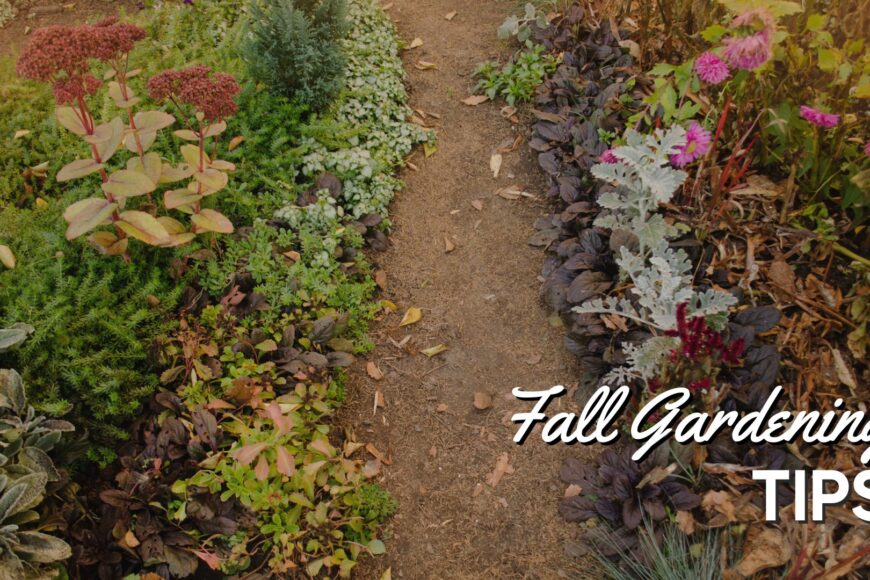With the arrival of fall comes the crisp air, vibrant foliage, and of course, the beloved pumpkin spice latte. But amidst the cozy autumn vibes, there’s also the not-so-glamorous task of cleaning up your garden. Luckily, we’ve got you covered! In this article, we’ll show you how to tackle cleanup and fall garden tips. Spend more time sipping your pumpkin spice latte and less time wielding garden rakes.
From raking up leaves and clearing out flowerbeds to prepping your soil for the next planting season, we’ll provide you with all the tips and tricks you need. Whether you’re a seasoned green thumb or are new to gardening, our guide will help streamline your fall cleanup routine, making it a breeze.
So put on your favorite cozy sweater, grab a warm drink, and get ready to transform your garden into a neat and tidy oasis. With our expert advice, you’ll have more time to enjoy the beauty of the season while ensuring your garden is ready to thrive for years to come.
Say goodbye to the mess and hello to a beautiful, well-maintained garden this fall. Let’s dive in!
Benefits of fall garden cleanup
Fall gardening cleanup may seem like a daunting task, but the benefits it brings to your garden are well worth the effort. By clearing out debris and preparing your garden for winter, you’re setting the stage for a healthy and vibrant garden come spring. Removing fallen leaves and dead plants helps prevent diseases and pests from overwintering, while also allowing your garden beds to breathe and receive ample sunlight. Additionally, proper fall cleanup can save you time and money in the long run, as it reduces the risk of plant diseases and the need for excessive pruning in the future.
Essential tools for fall garden cleanup
Before diving into your fall gardening cleanup, it’s important to have the right tools on hand. Here are some essential tools that will make your cleanup tasks a breeze

1. Garden Rake: A sturdy garden rake is essential for clearing fallen leaves, debris, and dead plants from your garden beds. Look for a rake with flexible tines that can easily glide over the soil without damaging plant roots.
2. Leaf Blower: If you have a large garden or a lot of trees, a leaf blower can be a time-saving tool for clearing leaves from pathways and hard-to-reach areas. Opt for a lightweight and powerful leaf blower that can handle both wet and dry leaves.
3. Pruning Shears: Pruning shears are necessary for trimming back dead or overgrown branches. Look for shears with sharp blades and a comfortable grip to make pruning a breeze.
4. Garden Waste Bags: Sturdy garden waste bags are essential for collecting and disposing of leaves, weeds, and other garden debris. Choose bags with reinforced handles and a large capacity to handle a significant amount of waste.
5. Wheelbarrow: A wheelbarrow will come in handy for transporting heavy garden waste and compost materials. Look for a wheelbarrow with a durable construction and large capacity to make hauling easier.
Having these tools readily available will ensure that you’re well-equipped to handle any fall gardening cleanup task that comes your way.
Steps for proper fall garden cleanup
Now that you have your tools ready, let’s dive into the steps for proper fall gardening cleanup. Follow these guidelines to ensure a thorough and efficient cleanup process.

1. Remove Dead Plants: Start by removing any dead or dying plants from your garden beds. These plants can harbor diseases and pests, which can spread to healthy plants if left untreated. Use your pruning shears to cut back dead or overgrown branches, and then carefully remove the plants from the soil.
2. Clear Out Debris: Use your garden rake or leaf blower to clear out fallen leaves, twigs, and other debris from your garden beds. Pay special attention to areas under trees and shrubs, as they tend to accumulate a higher volume of leaves. Be sure to remove debris from pathways and other areas where it may impede movement.
3. Weed Control: Fall is a great time to tackle weeds, as they are actively growing and competing with your desired plants for nutrients. Use your garden rake or hand trowel to remove weeds from the soil, making sure to remove the roots to prevent regrowth. Consider applying a layer of mulch to suppress weed growth and insulate plants during the winter months.
4. Cut Back Perennials: Many perennials benefit from a good pruning in the fall. Cut back the stems of your perennials to about 3-4 inches above the soil level, removing any dead or damaged parts. This will help promote healthy growth in the following spring.
5. Divide and Transplant: Fall is also an ideal time to divide and transplant certain perennials. Dig up clumps of overcrowded plants and separate them into smaller divisions, ensuring each division has enough roots and foliage to thrive. Transplant these divisions to new locations in your garden, or share them with fellow gardening enthusiasts.
By following these steps, you’ll be well on your way to a clean and well-prepared garden for the upcoming winter months.
Tips for composting garden waste
Instead of disposing of all your fall garden waste, consider composting it to create nutrient-rich soil for future use. Here are some tips for composting your fall garden waste.

1. Choose the Right Compost Bin: Select a compost bin that suits your needs and available space. There are various types of compost bins available, including tumblers, wire mesh bins, and wooden bins. Choose one that allows for proper aeration and moisture control.
2. Balance Your Compost: A successful compost pile requires a balance of green (nitrogen-rich) and brown (carbon-rich) materials. Green materials include fresh leaves, grass clippings, and kitchen scraps, while brown materials include dried leaves, straw, and shredded paper. Aim for a ratio of approximately 3 parts brown materials to 1 part green materials.
3. Chop or Shred Your Waste: To speed up the decomposition process, chop or shred your fall garden waste into smaller pieces. This will create more surface area for beneficial microorganisms to break down the materials.
4. Turn Your Compost: Regularly turning your compost pile helps aerate the materials and speed up decomposition. Use a garden fork or compost turner to mix the materials, ensuring that oxygen reaches all parts of the pile.
5. Monitor Moisture Levels: Compost should be moist, but not waterlogged. Monitor the moisture levels of your compost pile and adjust as needed. If the pile is too dry, add water; if it’s too wet, add dry materials such as leaves or shredded paper.
By following these tips, you’ll be well on your way to creating nutrient-rich compost that will enrich your garden soil and reduce the need for chemical fertilizers.
Preparing your garden for winter
In addition to cleaning up your garden, it’s important to take steps to prepare it for the winter months. Here are some key tasks to consider:
1. Mulching: Apply a layer of organic mulch around the base of your plants to help insulate their roots and protect them from freezing temperatures. Mulch also helps retain moisture in the soil and suppresses weed growth.
2. Protect Delicate Plants: If you have delicate plants that are not frost-tolerant, consider covering them with a frost cloth or burlap to protect them from freezing temperatures. This extra layer of protection can make a significant difference in their survival.
3. Clean and Store Garden Tools: Before winter sets in, take the time to clean and properly store your garden tools. Remove any dirt or debris from the surfaces, sharpen blades if necessary, and apply a light coat of oil to prevent rusting. Store them in a dry and protected area, such as a shed or garage.
4. Winterize Irrigation Systems: If you have an irrigation system in your garden, it’s important to properly winterize it to prevent freezing and damage. Drain any remaining water from the system and insulate exposed pipes to protect them from freezing temperatures.
By taking these steps to prepare your garden for winter, you’ll be ensuring the health and longevity of your plants during the cold months.
Common mistakes to avoid during fall garden cleanup
While fall gardening cleanup is essential, there are some common mistakes that gardeners often make. By avoiding these mistakes, you can ensure that your cleanup efforts are effective and beneficial for your garden:
1. Overlooking Hidden Pests: When cleaning up your garden, be on the lookout for hidden pests such as slugs, snails, and insect eggs. These pests can overwinter in fallen leaves and debris, so be thorough in your cleanup efforts to minimize their presence in your garden.
2. Not Composting Garden Waste: Instead of disposing of all your garden waste, take advantage of composting to create nutrient-rich soil. Composting not only reduces waste but also provides valuable organic matter for your garden.
3. Pruning at the Wrong Time: While fall is a great time to prune certain plants, it’s important to know which ones benefit from fall pruning and which ones should be pruned in spring. Research the specific pruning needs of your plants to ensure you’re pruning at the right time.
4. Ignoring Soil Health: Fall is an ideal time to improve soil health by adding organic matter such as compost or well-rotted manure. Ignoring soil health can lead to nutrient deficiencies and poor plant growth in the future.
By avoiding these common mistakes, you’ll be well on your way to a successful fall gardening cleanup that sets the stage for a beautiful garden in the upcoming spring.
Fall garden cleanup checklist
Here’s a handy checklist for your fall garden cleanup.
1. Remove dead plants and debris from garden beds.
2. Clear out fallen leaves and twigs from pathways and other areas.
3. Weed garden beds and apply a layer of mulch.
4. Cut back perennials and divide or transplant as needed.
5. Compost garden waste to create nutrient-rich soil.
6. Apply organic mulch around the base of plants.
7. Protect delicate plants from freezing temperatures.
8. Clean and store garden tools.
9. Winterize irrigation systems if applicable.
By following this checklist, you’ll be well-prepared to tackle your fall gardening cleanup with ease.
Enjoying a well-prepared garden for the upcoming spring
Fall gardening cleanup may not be the most glamorous task, but it is essential for maintaining a healthy and vibrant garden. By following the steps and tips outlined in this article, you’ll be well on your way to a clean and well-prepared garden for the upcoming winter months. So put on your favorite cozy sweater, grab a warm drink, and get ready to transform your garden into a neat and tidy oasis.
With our expert advice, you’ll have more time to enjoy the beauty of the season while ensuring your garden is ready to thrive for years to come.
Say goodbye to the mess and hello to a beautiful, well-maintained garden this fall. Happy gardening!
Related
Have a Question?
We love to help gardeners and plant lovers of all skill and experience lovers. Stop by our greenhouse and garden center and ask one of our experts.
About Us
We are Mukwonago’s best choice for trees, shrubs, plants and flowers for your garden. Plus see our extensive collection of houseplants and gardening supplies. Our garden center is located near Lake Geneva, Racine and Waukesha.


